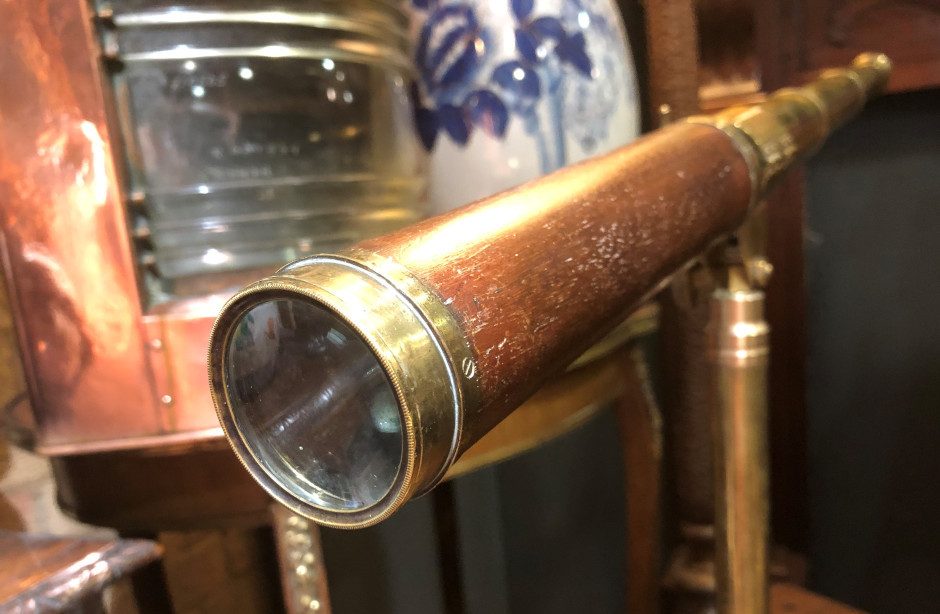
From scientists to sailors, magnifying instruments have aided the crafts and lives of many. Technical brilliance combined with beautiful decoration make them a collector's dream.
Not all antique telescopes and microscopes are made equal, of course. Optical instruments sit on a spectrum of sophistication, ranging from pearl-smothered opera glasses to six-foot stargazers. As you’d expect, this means they also vary in price. Let’s take a look…
Antique telescopes
Offering a view of space as it was seen in the early 17th century, the oldest antique telescopes come from the Netherlands. Giant leaps were being made in science and arts at the time - and these brass beauties have been coveted ever since. In 2013, a 1719 Italian binocular telescope by Milanese optician Pietro Patroni sold for a record £338,500 at Christie’s famous auction house.
For those on a budget, simple handheld antique telescopes can be bought for less than £100 - although they can be five times that price if signed by a good maker (look for Ramsden, Dolland or Adams).
There are two types of antique telescopes for sale you might find - reflectors and refractors:
● Reflecting telescopes came first, using a concave mirror to form an image. 18th-century examples value between £500 to £3,000.
● Refracting telescopes use glass lenses to enhance an image - Isaac Newton built the first practical example in the late 17th century.
Look closely at materials. Antique telescopes generally have tubes made from brass, pasteboard or wood. Those used by sailors tend to be bound with plaited rope or mahogany, while military pieces are finished off with leather.
Antique microscopes
Like telescopes, antique microscopes fall into two types: simple microscopes (which you may know as magnifying glasses) and compound microscopes (those with two or more lenses).
● Simple antique microscopes
Most simple microscopes are small and basic, made of brass and can barely focus on the image or specimen. This doesn’t lessen their value - an 18th-century example by a maker such as Edmund Culpeper, with its original case and accessories, can fetch over £1,000 at auction. You might also stumble upon a ‘screw-barrel’ on your hunt for antique microscopes for sale. Designed specifically for field trips, these common pieces can value between £500 and £1,000.
● Compound antique microscopes
Edmund Culpeper was also the maker of many compound microscopes. Between the 1720s and the early 19th century, these skilful instruments came in a pyramid-shaped case. Examples from the 1730s and 1740s can be identified by a crossed-daggers symbol. If you put one of these up for sale, you could be leaving an auction with an extra £5,000 in the bank - even basic examples value at up to £1,500. Other valuable makers’ names to look out for are Andrew Ross, Powell & Lealand and Smith & Beck - all London makers of antique microscopes which command some of the highest prices at auction.
Antique opera glasses
From windows to the universe to flamboyant accessories, antique opera glasses are the perfect niche for collectors or dealers on a humble budget. With less magnifying strength than antique telescopes, these gorgeous pieces were used for closer viewing of operas or plays. Depending on materials, makers and models, you can find antique opera glasses for sale anywhere between £100 to £1,000.
Where to find antique telescopes & microscopes for sale
We have buyers from all over the country (and beyond) dropping into Hemswell Antiques Centres to ooh and ahh at our scientific instruments for sale. There’s a unique delight in viewing space as it was seen centuries ago, or inspecting antique microscopes and imagining an 18th-century scientist’s eureka! moment.
Only a fraction of our antiques are on our website, so come seek even more pieces out in our treasure houses. We’re the largest antique centre in Europe, in lovely little Lincoln. Here’s how to reach us - you’ll want to pencil in a day to explore every surprising corner awaiting your arrival. Happy hunting!